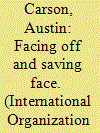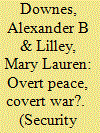|
|
|
Sort Order |
|
|
|
Items / Page
|
|
|
|
|
|
|
| Srl | Item |
| 1 |
ID:
143759


|
|
|
|
|
| Summary/Abstract |
This article examines the relationships between the CIA and the US domestic press during the 1950s through the lens of CIA covert interventions in Guatemala and Indonesia. It disputes interpretations of the press/CIA relationship that argue for significant control exercised by the CIA, and contends that there were several types of press/CIA relationship, ranging from cooperation to hostility. The most common relationship was one of friendly confluence, rooted in Cold War considerations; even well-disposed reporters, though, tended to be careful about preserving their independence. This article concludes that while the CIA/press relationships generally resulted in reporting favorable to the CIA, there were counter-trends in the 1950s that laid the groundwork for the later collapse of the CIA's public image.
|
|
|
|
|
|
|
|
|
|
|
|
|
|
|
|
| 2 |
ID:
145011


|
|
|
|
|
| Summary/Abstract |
States pursue their cooperative and competitive goals using both public and private policy tools. Yet there is a profound mismatch between the depth, variety, and importance of covert activity and what scholars of International Relations (IR) know about it. This article addresses this gap by analyzing how adversaries struggle for influence within the covert sphere, why they often retreat to it, and when they abandon it. It focuses on secrecy among adversaries intervening in local conflicts and develops a theory about secrecy's utility as a device for creating sustainable limits in war. Drawing on insights about secrecy and face-work from the sociologist Erving Goffman, I show that major powers individually and collectively conceal evidence of foreign involvement when the danger of unintended conflict escalation is acute. Doing so creates a kind of “backstage” in which adversaries can exceed limits on war without stimulating hard-to-resist pressure to escalate further. An important payoff of the theory is making sense of puzzling cases of forbearance: even though adversaries often know about their opponent's covert activity, they often abstain from publicizing it. Such “tacit collusion” arises when both sides seek to manage escalation risks even as they compete for power and refuse to capitulate. The article evaluates the theory via several nested cases of external intervention in the Korean War. Drawing on newly available materials documenting the covert air war between secretly deployed Soviet pilots and Western forces, the cases show how adversaries can successfully limit war by concealing activity from outside audiences. Beyond highlighting the promise in studying the covert realm in world politics, the article has important implications for scholarship on coercive bargaining, reputation, state uses of secrecy, and how regime type influences conflict behavior.
|
|
|
|
|
|
|
|
|
|
|
|
|
|
|
|
| 3 |
ID:
097371


|
|
|
|
|
| Publication |
2010.
|
| Summary/Abstract |
Proponents and critics of the democratic peace have debated the extent to which covert attempts by democracies to overthrow other elected governments are consistent with or contradict democratic peace theory. The existing debate, however, fails to acknowledge that there are multiple democratic peace theories and that inter-democratic covert intervention might have different implications for different arguments. In this article, we first distill hypotheses regarding covert foreign regime change from three theories of democratic peace. Relying primarily on declassified government documents, we then investigate these hypotheses in the context of U.S. covert intervention in Chile (1970-73). The evidence suggests that covert intervention is highly inconsistent with norms and checks-and-balances theories of democratic peace. The evidence is more consistent with selectorate theory, but questions remain because democratic leaders undertook interventions with a low likelihood of success and a high likelihood that failure would be publicized, which would constitute exactly the type of policy failure that democratic executives supposedly avoid.
|
|
|
|
|
|
|
|
|
|
|
|
|
|
|
|
| 4 |
ID:
181027


|
|
|
|
|
| Summary/Abstract |
Overt interventions to forcibly promote regimes abroad are often a risky undertaking. If successful, they can replace or rescue regimes and signal resolve in the process. But open meddling can also trigger large-scale escalation, incite nationalist backlash, and harm a state’s reputation. Despite an emerging consensus that states often prefer covert action to avoid these liabilities, leaders sometimes opt for overt action anyway. Why? Drawing on the concept of loss aversion, this article argues that leaders’ tolerance for risk differs depending on whether the goal is to overthrow a foreign regime or prop one up. Because regime rescue approximates loss prevention, leaders are more likely to pursue risky intervention strategies than they are to change regimes, a prospective gain. This framework helps explain why leaders are more likely to accept the risks of overt action when saving a foreign regime and more likely to go covert when deposing one. I evaluate this theory using the Eisenhower administration’s covert regime change efforts in Syria (1956–57) and overt regime rescue attempts in Lebanon (1958).
|
|
|
|
|
|
|
|
|
|
|
|
|
|
|
|
|
|
|
|
|